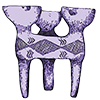Characters of Suat Derviş between the Social and Individual: Gendered Bodies and Embodied Emotions from Darkness to Nothingness
DOI:
https://doi.org/10.33831/jws.v24i2.422Keywords:
feminist literature, gender, individualism, Suat Derviş, Turkish literatureAbstract
In the context of the fact that canonical literary works are predominantly formed within Western literature and that even the critiques are mainly coming from Western feminists, this paper primarily explores the potentials of canonization in Turkish literature. The study examines Suat Derviş's works, drawing parallels between Derviş's name, personality, and struggle, and how characters from Kara Kitap to Hiç are portrayed in terms of their class, social, and gender backgrounds. The article discusses the relationships between Derviş's characters and the embodiment of their bodies by questioning the possibility of canonization of feminist literature and women's narratives within Suat Derviş's literature.
References
Ancet, P. (2010). Ucube Bedenlerin Fenomenolojisi. E. Topraktepe, (Çev.). İstanbul: Yapı Kredi.
Bloom, H. (1995). The Western canon: the books and school of the ages. 1st Riverhead ed. New York, Riverhead Books.
Butler, J. (1998). Toplumsal Cinsiyet Yanıyor: Sahiplenme ve Yıkma Sorunları. Defter, 34: 123-141.
Derviş, S. (2013a). Hiç. İstanbul: İthaki.
Derviş, S. (2013b). Ankara Mahpusu. İstanbul: İthaki.
Derviş, S. (2013c). Fosforlu Cevriye. İstanbul: İthaki.
Derviş, S. (2014a). Kara Kitap. İstanbul: İthaki.
Derviş, S. (2014b). Aksaray’dan Bir Perihan. İstanbul: İthaki.
Derviş, S. (2017). Anılar, Paramparça. İstanbul: İthaki.
Dillon, S. (2017). Palimpsest: Edebiyat, Eleştiri, Kuram. F. B. Aydar, (Çev.). İstanbul: Koç Üniversitesi.
Garan Gökşen, B. (2022). Sakatlık çalışmaları bağlamında Suat Derviş’in Kara Kitap ve Şule Gürbüz’ün Kambur adlı eserlerine bir bakış. s.617-624. Academy Global Publishing House.
Gilbert, S. M ve S. Gubar (2000). The Madwoman in the Attic: The Woman Writer and the Nineteenth-Century Literary Imagination. Yale University Press.
Grosz, E. (1994). Volatile Bodies: Toward a Corporeal Feminism. Indiana: Indiana University.
Günay, Ç. (2001). Toplumcu Gerçekçi Türk Edebiyatında Suat Derviş’in Yeri. Bilkent Üniversitesi Türk Edebiyatı Bölümü Master Tezi, Ankara.
Günaydın, A. U. (2015). Suat Derviş’in Hiçbiri ve Çılgın Gibi Romanlarında Aşk ve Sevgisizlik Teması Üzerinden Cinsiyet İlişkilerine Bakış, Yıldızları Seyreden Kadın: Suat Derviş Edebiyatı içinde, G. Sönmez İşçi (Der.), s. 171-183. İstanbul: İthaki.
Kaya, Ş. (2018). Suat Derviş’in Romanlarında Kadın Karakterler. Folklor/Edebiyat, 24(96). 97-110.
Moran, B. (2013). Edebiyat Kuramları ve Eleştiri. (24. Bs.). İstanbul: İletişim.
Oktay, A. (2008). Toplumcu Gerçekçiliğin Kaynakları: Sosyalist Realizm Üstüne Eleştirel Bir Çalışma. (4 Bs.). İstanbul: İthaki.
Parla, J. (2011). “Kadın Eleştirisi Neyi Gerçekleştirdi?”. Kadınlar Dile Düşünce. Der. Sibel Irzık ve Jale Parla. (4. Bs.). İstanbul: İletişim.
Sakman, N. (2018). Kendine Ait Bir Kalem: Kadın Yazını Üzerine. İstanbul: İthaki.
Sontag, S. (2015). Yoruma Karşı. O. Akınhay, (Çev.). İstanbul: Agora.
Stanley, L. (1994). The Knowing Because Experiencing Subject: Narratives, Lives, and Autobioraphy. In Knowing the Difference: Feminist Perspectives in Epistemology, K. Lennon & M. Whitford, (Ed.), pp.132-148. London & New York: Routledge.
Downloads
Published
Issue
Section
License
Copyright (c) 2024 Kadın/Woman 2000, Journal for Women's Studies

This work is licensed under a Creative Commons Attribution-NonCommercial 4.0 International License.
Authors who publish with this journal agree to the following terms:
- Authors retain copyright and grant the journal right of first publication, with the work [6 months] after publication simultaneously licensed under a Creative Commons Attribution License that allows others to share the work with an acknowledgement of the work's authorship and initial publication in this journal.
- Authors are able to enter into separate, additional contractual arrangements for the non-exclusive distribution of the journal's published version of the work (e.g., post it to an institutional repository or publish it in a book), with an acknowledgement of its initial publication in this journal.
- Authors are permitted and encouraged to post their work online (e.g., in institutional repositories or on their website) prior to and during the submission process, as it can lead to productive exchanges, as well as earlier and greater citation of published work (See The Effect of Open Access)







